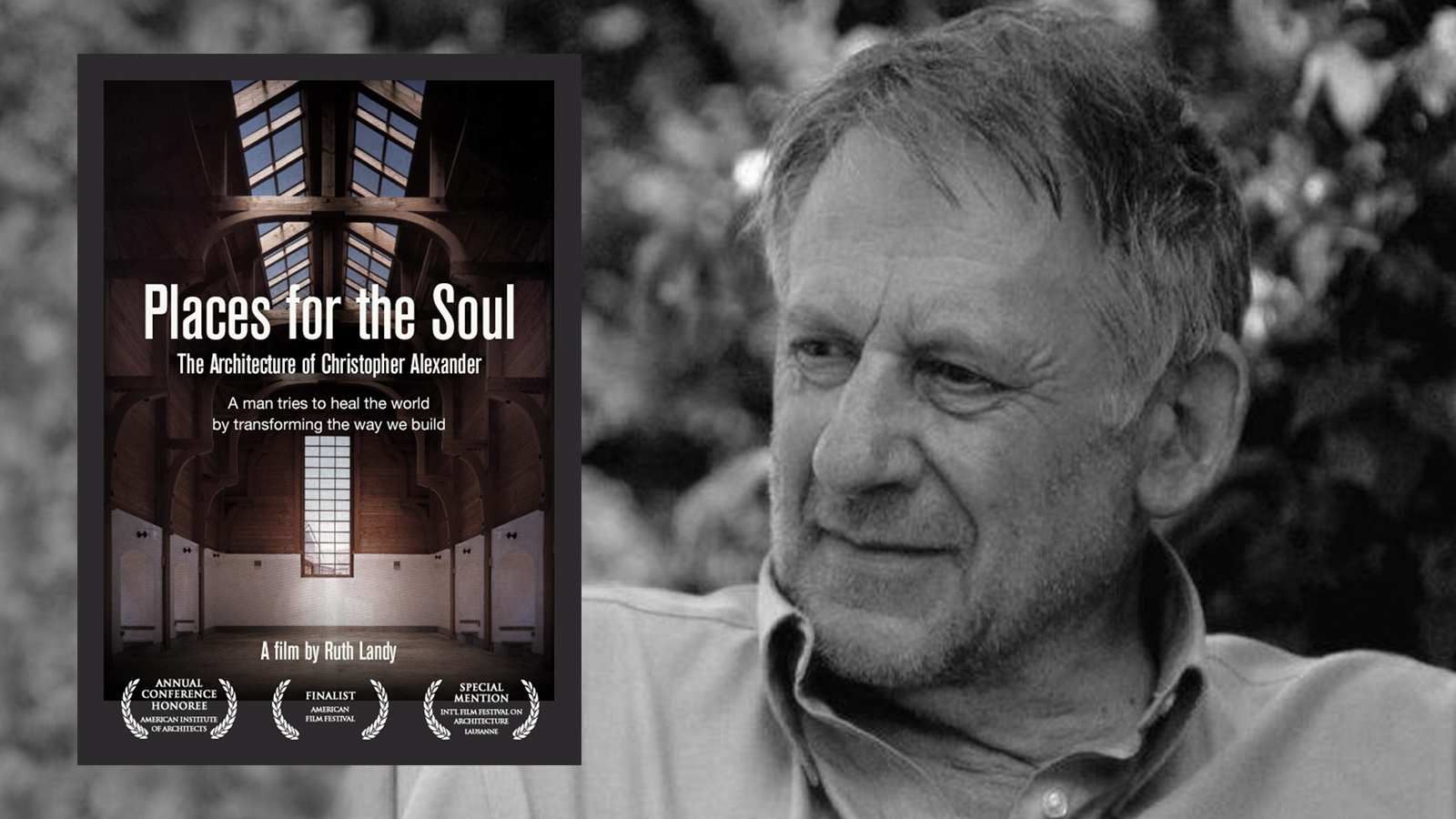We have met mathematician and architect Christopher Alexander before in these pages given the close resonance between his work and the concept of the conscious city: his ideas of co-joined patterns of space and patterns of human activity (and need); how these ideas are prescient of the findings now from neuroscience research about how we use and are influenced by space; and his use of set theory to illustrate how cities gain their life through complexity rather than the simplicities that too-often result from the interventions of designers, planners and managers.
But while still relevant – and critically so – much of this work is now some 40 to 50 years old. Alexander’s own explorations continued, culminating in a new philosophy around space and matter and life itself; in effect a new cosmology that connects the geometrical properties of space, how we operate within and engage with that space (and other objects), and our felt awareness of all of this.
Alexander explains it all in a 4-volume magnum opus published between 2001 and 2005: The Nature of Order. An Essay on the Art of Building and The Nature of the Universe1– all 2,150 pages of it! A very readable summation can be found in Jenny Quillien’s book Delight’s Muse on Christopher Alexander’s The Nature of Order2, drawing on her work as Alexander’s assistant at the time.
Another entrée is now provided in the re-release on video of a 1990 documentary by connection-agent Ruth Landy: Places for the Soul: the Architecture of Christopher Alexander. It includes extensive commentary by Alexander himself where he explains in succinct and enticing grabs, and in the midst of its development, the essential components of his expanded theory and how he got there.
Some examples:
‘The crux of the issue is, wholeness is a real thing … a real palpable thing we can understand and discover. Above all it is real, not a matter of opinion or private taste.’
‘The key to [objects and space which have this wholeness] is that no part does not have a deep infusion of life into it.’
‘This is completely different to how buildings are created today – because we don’t see this as the point. [We need] a new approach to architecture where feeling comes first and process is paramount. Life cannot be produced from [an architectural] drawing, only from a process.’
And, in response to the interviewer’s question ‘can you verbalise the outcome of such a process’:
‘Make God appear in the middle of a field.’
Alexander contends that such aims and processes were inherent within ‘traditional’ building and city-making processes – where ‘they all share a lack of their own self-importance because they are concentrating on what life is …’. They are, as he says elsewhere, ‘egoless’3. All of which is why we still find the resultant places comfortable, and pleasant to use and be in. The task now is how to achieve this in our current age, where we are ‘imprisoned within the idea of images and surfaces which are oddly insincere and [where that insincerity] in a way makes you feel like death almost more than the building itself.’
The video details two constructed examples, with footage of both the design and construction processes: a shelter for the homeless in California, and a secondary school in Japan.
And it is here that some doubts start to creep in. On a visual appraisal at least, the resultant architecture tends not to inspire, at least for this reviewer. The shelter seems fussy, unnecessarily over-embellished. And the school is in parts lumpy and forbidding.
Here also the video transcends being mere hagiography by including interviews with the commissioning clients of both projects. Both engaged Alexander because of the consistency of his ideas with their own aims and intentions. However, and although appreciative of Alexander’s participatory design approach with (intended) residents, teachers and students, they also revealed some fundamental problems. In particular, over-runs in time and budget due to overly-extended attention to detail and process, and Alexander’s dogged insistence around certain matters.
There is some sense of concern about all of this in reflective comment by Alexander himself – but only to a degree; problems with the building contractor for the school for instance have since been described, somewhat grandly, in a separate book as a ‘clash’ of world views.4
But these observations should not distract from the overall importance of Alexander’s oeuvre. Maybe Alexander is simply a better theorist than architect; and maybe, as seems to be suggested also by Jenny Quillien, Alexander still struggled to fully transcend his own designer’s ego. More importantly, feedback from users of both projects suggests they are satisfied.
So let’s not lose sight of the importance – and difficulty – of what Alexander is essentially on about: the necessary achievement of a bigger project that affects us all. It transcends the mere, too-common, but also lazy, transactional application of ideas or fashions or habits (including, as Alexander himself has noted5, the 253 individual patterns in Alexander’s earlier comprehensive – and famous – A Pattern Language6).
As suggested in the subtitle of the video, this larger project is about using our individual skills and interests and orientations to make not just better buildings and spaces, policies and management regimes, but the achievement of the world as a whole as a progressively better place.
This, Alexander contends, means attention to the task of expanding life itself, requiring (amongst other process matters) an honest application of our too-often overlooked felt personal knowledge of how we want things to be; where, in another grab from the video, ‘people start to feel their own humanity and start to feel more connected to everything.’7
As Alexander further proposes (or indeed instructs!), in a more recent (2016) summation of what is now his life’s work:
Earth – our physical Earth and its inhabitants – sand, water, rocks, birds, animals, and trees – this is the garden in which we live. We must choose to be gardeners. We must choose to make the garden beautiful. Understanding this will give us intellectual insight into the nature of … something which lies under the surface of all matter, and which comes to life and shines forth when we treat the garden properly.8
You can access a trailer of Places for the Soul and the full 30 minute video from Ruth Landy’s own website. It is also available on Amazon Prime.
Alexander passed away in 2022. His A Pattern Language compilation is now available on the web for download from various sites, including here.
References
1 Christopher Alexander (2001-2005): The Nature of Order: An Essay on the Art of Building and the Nature of the Universe.
- Book One: The Phenomenon of Life. Oxford University Press (2001).
- Book Two: The Process of Creating ife. The Center for Environmental Structure (2002).
- Book Three: A Vision of a Living World. The Center for Environmental Structure (2005).
- Book Four: The Luminous Ground. The Center for Environmental Structure (2004).
2 Jenny Quillien (2008): Delight’s Muse on Christopher Alexander’s The Nature of Order: A summary and personal interpretation. Culicidae Press.
3 See for example Christopher Alexander (1979): The Timeless Way of Building. Oxford University Press.
4 Christopher Alexander, Hajo Neis & Maggie Moore-Alexander (2012): The Battle for the Life and Beauty of the Earth. A struggle between two world systems. Oxford University Press.
5 See for example: Stephen Grabow, Christopher Alexander: The Search for a New Paradigm in Architecture (Oriel Press, 1983); Michael Mehaffy, ‘A conversation with Christopher Alexander’, Katarxis No. 3, September 2004.
6 Alexander, C., Ishikawa, S., Silverstein, M., Jacobson, M., Fiksdahl-King, I., & Angel, S. (1977). A Pattern Language. Oxford University Press. New York.
7 A more detailed description of this extended idea of ‘healing’ the world, in reference to the similar aims of the renowned educationalist Paulo Freire, is given in a conference paper to the 2018 PUARL conference on pattern languages: Ana Pinto (2018) “Learning cities and adult (literacy) learners: designing a better world”.
8 Christopher Alexander (2016): “Making the Garden” in First Things, February 2016.

